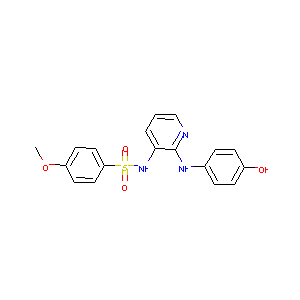Details of the Drug
General Information of Drug (ID: DMNG35S)
| Drug Name |
ABT-751
|
||||||||||||||||||||||
|---|---|---|---|---|---|---|---|---|---|---|---|---|---|---|---|---|---|---|---|---|---|---|---|
| Synonyms |
ABT-751; 141430-65-1; ABT 751; E-7010; ABT751; ABT-751 (E7010); UNII-WDT5V5OB9F; E 7010; WDT5V5OB9F; N-[2-[(4-HYDROXYPHENYL)AMINO]-3-PYRIDYL]-4-METHOXYBENZENESULFONAMIDE; CHEMBL20684; N-(2-((4-Hydroxyphenyl)amino)-3-pyridinyl)-4-methoxybenzenesulfonamide; N-{2-[(4-hydroxyphenyl)amino]pyridin-3-yl}-4-methoxybenzenesulfonamide; Benzenesulfonamide,N-[2-[(4-hydroxyphenyl)amino]-3-pyridinyl]-4-methoxy-; N-(2-(4-hydroxyphenylamino)pyridin-3-yl)-4-methoxybenzenesulfonamide
|
||||||||||||||||||||||
| Indication |
|
||||||||||||||||||||||
| Drug Type |
Small molecular drug
|
||||||||||||||||||||||
| Structure |
 |
||||||||||||||||||||||
| 3D MOL | 2D MOL | ||||||||||||||||||||||
| #Ro5 Violations (Lipinski): 0 | Molecular Weight (mw) | 371.4 | |||||||||||||||||||||
| Logarithm of the Partition Coefficient (xlogp) | 2.8 | ||||||||||||||||||||||
| Rotatable Bond Count (rotbonds) | 6 | ||||||||||||||||||||||
| Hydrogen Bond Donor Count (hbonddonor) | 3 | ||||||||||||||||||||||
| Hydrogen Bond Acceptor Count (hbondacc) | 7 | ||||||||||||||||||||||
| Chemical Identifiers |
|
||||||||||||||||||||||
| Cross-matching ID | |||||||||||||||||||||||
| Combinatorial Drugs (CBD) | Click to Jump to the Detailed CBD Information of This Drug | ||||||||||||||||||||||
Molecular Interaction Atlas of This Drug
 Drug Therapeutic Target (DTT) |
|
|||||||||||||||||||||||||||||||
|---|---|---|---|---|---|---|---|---|---|---|---|---|---|---|---|---|---|---|---|---|---|---|---|---|---|---|---|---|---|---|---|---|
 Drug-Metabolizing Enzyme (DME) |
|
|||||||||||||||||||||||||||||||
| Molecular Interaction Atlas (MIA) | ||||||||||||||||||||||||||||||||
References
